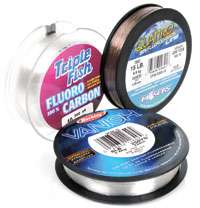
Fluorocarbon line isn’t an option for many anglers anymore. It’s a necessity. “I used to use it about 10 percent of the time,” said Cliff Pace, a Bassmaster Elite Series angler from Mississippi. “Now I use it about 85 percent of the time.” Lake Lanier guide Mike Bucca added, “At first, I used fluorocarbon on spinning reels for finesse applications. Now that things have advanced, I use fluorocarbon about 90 percent of the time for all applications, except float-and-fly and big swimbaits.” Since fluorocarbon became available as a fishing line 10 years ago, that considerable change in attitude is primarily because of considerable improvement in the product. A slight price reduction also has played a role in its increased popularity, but enhanced quality is what has elevated fluorocarbon to nearly equal status with monofilament as the line most often used. Many of those who first filled their spools with fluorocarbon found it to be brittle, with too much memory and poor knot strength, especially in strengths of 10 pound test and higher. “Back several years ago, you could feel the inconsistencies in fluorocarbon,” said Bucca, an advocate of the Triple Fish brand. “But now I’ve noticed that more companies are getting better at producing a smoother line. If you run your hands up and down the line, it is very smooth, with a diameter that is more consistently round.” Today’s fluorocarbon is “much, much better than the original,” added Clay Norris, a senior product manager for Pure Fishing. “With Berkley Vanish, we’ve made six [formulation] improvements. It’s still thin and still at a good price, but we’ve worked hard to make it more flexible and have better impact strength.” At Triple Fish, several reformulations have made today’s fluorocarbon line “relaxed and very manageable,” said Dave Burkhardt, company owner. “It’s mindless on the spool. You can focus on fishing and not on the line.” Today’s Triple Fish fluorocarbon also has 7 percent smaller diameter than premium monofilament, Burkhardt said. Competition has been a key to the improvements in fluorocarbon, according to Pace, who prefers Hi-Seas. “At first, there were just two or three brands,” he said. “But now, just about every company has one, and they have had to step up to make their products stand out. I like Hi-Seas because it is soft and subtle.” While fluorocarbon has been improved in terms of manageability, strength and consistency, it still possesses qualities that made it attractive in the first place: Because of its refractive ability, it nearly disappears in water. It’s denser than monofilament, meaning it sinks faster and is more sensitive. It’s more resistant to degradation by ultraviolet light. It doesn’t absorb water. And it has less stretch, allowing for a quicker and more efficient hook-set than with monofilament. As more and more anglers recognize these benefits and discover that the old criticisms don’t apply anymore, companies are increasing the variety of their offerings to take advantage of fluorocarbon’s heightened popularity. For example, Berkley offers “professional grade” Trilene 100% Fluorocarbon, as well as traditional Vanish. “The 100% was our big breakthrough for the bass market about three years ago,” Norris said. “We had never called our fluorocarbon Trilene. But once we had a line that met all the rigors, we decided that we could brand it that way. It is more expensive because it made with a special resin.” Pace fishes Hi-Seas’ new Quattro Fluorocarbon with four-color camouflage. “Fluorocarbon is not 100 percent invisible,” explained Hi-Seas spokesman Will Bellucci. “The camo acts as a stopper to light that travels down the line. If a fish sees that light, it doesn’t see a solid piece of line because the pattern breaks it up.” These options are a long, long way from the fluorocarbon line of a decade ago. Back then, its low visibility was its chief selling point, and it only found its way into the freshwater market after companies found a way to produce it at a reasonable cost. Before that, it had been used exclusively as leader material, mostly in saltwater. “There’s still a learning curve for anglers with fluorocarbon,” Norris cautioned. “For example, you want to wet your knots and tie them slowly. Fluorocarbon is sensitive to friction. On the positive side, I’ve heard the pros say they retie less often.” Versatility With fluorocarbon so popular for so many applications today, it’s easier to point out when it’s not the best line choice, as opposed to when it is. “Because fluorocarbon is denser and sinks faster, it’s not really good for topwaters,” said Berkley’s Norris. “And braid probably is better for flipping because it’s stronger and invisibility isn’t important.” Burkhardt added, “If you’re fishing emergent vegetation with a soft jerkbait, your bait won’t be as buoyant with fluorocarbon and you’ll sink into the grass more.” Bucca warns against using fluorocarbon with plus-size lures, such as 4-ounce swimbaits. “When you are throwing big baits, there is a lot of torque at the knot, and mono is better at taking this excessive abuse,” he said. With just about everything else, fluorocarbon works well, although some anglers might prefer other lines for a variety of reasons. “I feel that it’s advantageous to use fluorocarbon on diving lures, such as jerkbaits and crankbaits,” said Bucca. “Fluorocarbon is denser, which allows it to sink faster than mono. You get more depth out of your bait.” Pace likes the quicker fall for weightless soft baits, such as Senkos, adding that the low stretch provides more sensitivity and a more natural presentation. Bucca also likes to throw soft plastics with fluorocarbon, especially when he’s fishing for spotted bass around rocks. He admits that braid is better for sheer strength and sensitivity. But fluorocarbon offers better abrasion resistance than mono, and its near invisibility is a decided advantage over both braid and mono.





